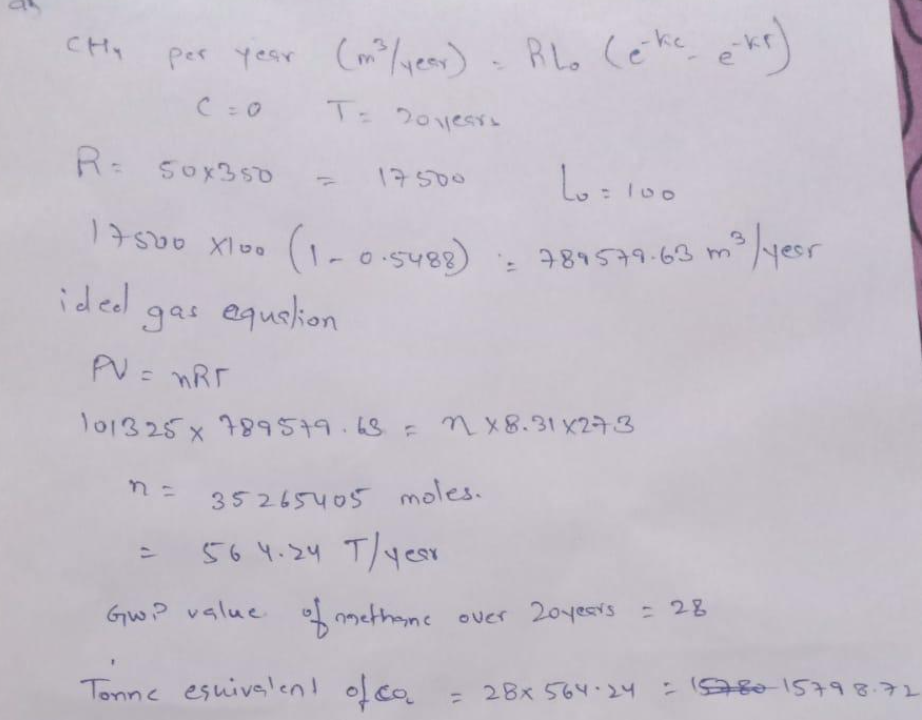2. [landfills, reduction of GWP emissions] A paper mill landfills 50 metric tonnes per day of solid waste composed primarily of sludge/solids from wastewater treatment plant, ash, and other miscellaneous waste typical of a kraft mill. The mill generates solid waste for 350 days a year. The landfill has been in use for 20 years and remains active. The decay of the solid waste in the landfill produces a biogas rich in methane. The amount of methane generated can be estimated by using the simplified first order decay equation given in the supplementary information. a) The landfill does not have a collection and recovery system for the biogas and the methane is released to the atmosphere. Calculate the amount of greenhouse gases emitted to the atmosphere due to the methane release from the landfill. Use the most recent GWP value for methane (IPCC AR5 value) in your calculations and answer in tonnes of CO2 equivalents per year, t CO₂e/y. [Ans: = 15,780 t CO₂e/y]
Thermochemistry
Thermochemistry can be considered as a branch of thermodynamics that deals with the connections between warmth, work, and various types of energy, formed because of different synthetic and actual cycles. Thermochemistry describes the energy changes that occur as a result of reactions or chemical changes in a substance.
Exergonic Reaction
The term exergonic is derived from the Greek word in which ‘ergon’ means work and exergonic means ‘work outside’. Exergonic reactions releases work energy. Exergonic reactions are different from exothermic reactions, the one that releases only heat energy during the course of the reaction. So, exothermic reaction is one type of exergonic reaction. Exergonic reaction releases work energy in different forms like heat, light or sound. For example, a glow stick releases light making that an exergonic reaction and not an exothermic reaction since no heat is released. Even endothermic reactions at very high temperature are exergonic.
for part a) can someone show how we get from 35265405 moles to 564.24tonne/year
![2. [landfills, reduction of GWP emissions] A paper mill landfills 50 metric tonnes per day of solid waste
composed primarily of sludge/solids from wastewater treatment plant, ash, and other miscellaneous waste
typical of a kraft mill. The mill generates solid waste for 350 days a year. The landfill has been in use for
20 years and remains active. The decay of the solid waste in the landfill produces a biogas rich in methane.
The amount of methane generated can be estimated by using the simplified first order decay equation
given in the supplementary information.
a) The landfill does not have a collection and recovery system for the biogas and the methane is released
to the atmosphere. Calculate the amount of greenhouse gases emitted to the atmosphere due to the
methane release from the landfill. Use the most recent GWP value for methane (IPCC AR5 value) in
your calculations and answer in tonnes of CO2 equivalents per year, t CO₂e/y.
[Ans: = 15,780 t CO₂e/y]
b) Consider that the landfill is fitted with a "collection + combustion" system to harness the calorific value
of the generated methane and reduce CH4 emissions. The system has a collection efficiency of 75%
and 10% of the uncollected meth is oxidised before escaping to the atmosphere. collected
methane is burned.
i. Calculate the amount of greenhouse gases emitted solely due to the methane that still escapes
from the landfill.
[Ans: = 3,550 t CO2e/y]
ii. Assuming perfect combustion of the collected methane, calculate the percentage net reduction in
greenhouse gas emissions that is attained by fitting the "collection + combustion" system.
[Ans: = 70% net reduction in GHG emissions]
Supplementary information:
• Assume that the methane is generated and collected or released/emitted always at 0°℃ and 1atm.
• CH₁ generated from waste in landfill (m³/year) = R L₁ (e-kC – e-kT)
with: R = average amount of waste sent to landfill per year (t/y)
Lo = ultimate methane generation potential = 100 m³ of CH4/t of waste
k = methane generation rate constant = 0.03 y¹
C = time since landfill stopped receiving waste (y)
T = time since landfill opened (y)
R = 8.31446 J K-¹ mol1¹ = 0.082057 L atm K-1 mol¹; 1 atm = 101325 Pa.](/v2/_next/image?url=https%3A%2F%2Fcontent.bartleby.com%2Fqna-images%2Fquestion%2Fde55ad6b-27eb-44c5-bca1-afdb32f2dfc7%2F0d3646cc-948b-468b-b1b7-6e45b64c7d25%2Fhazi3eg_processed.png&w=3840&q=75)

Step by step
Solved in 3 steps with 6 images


